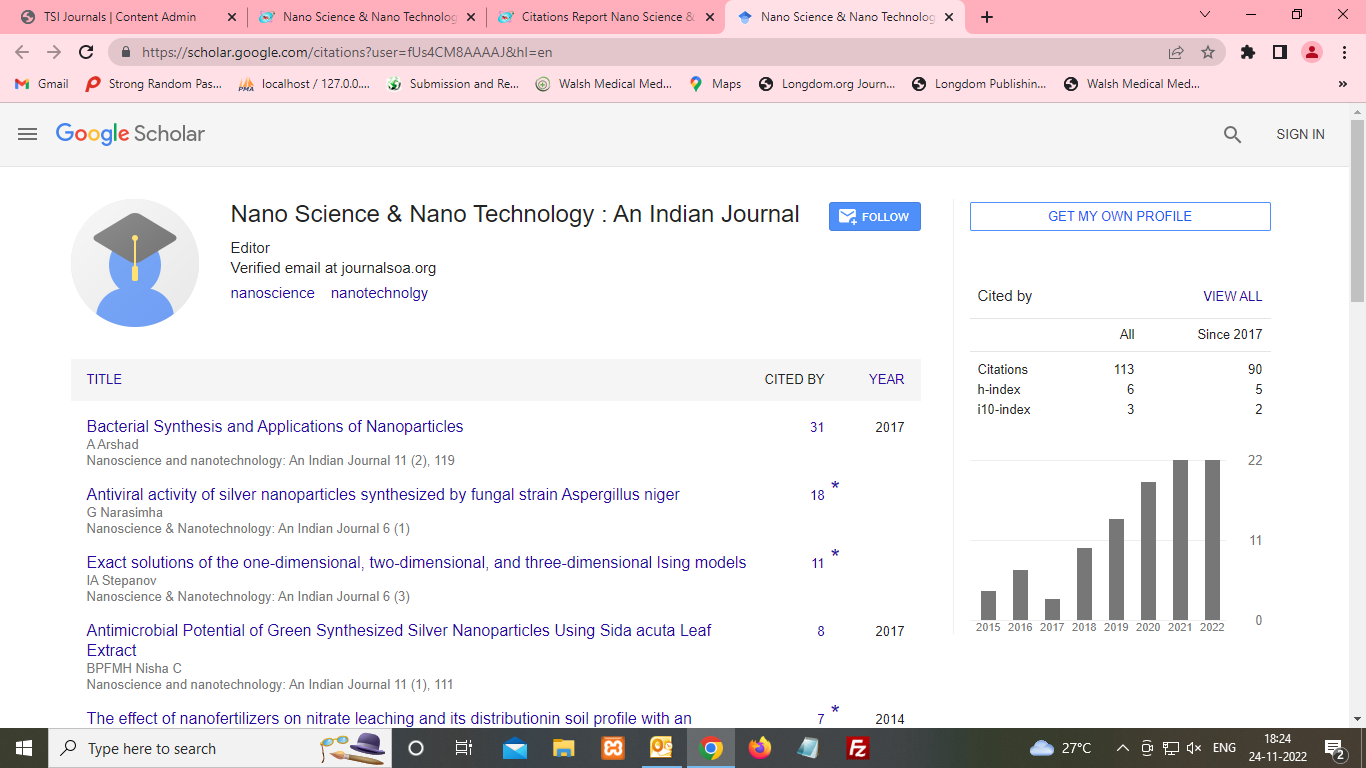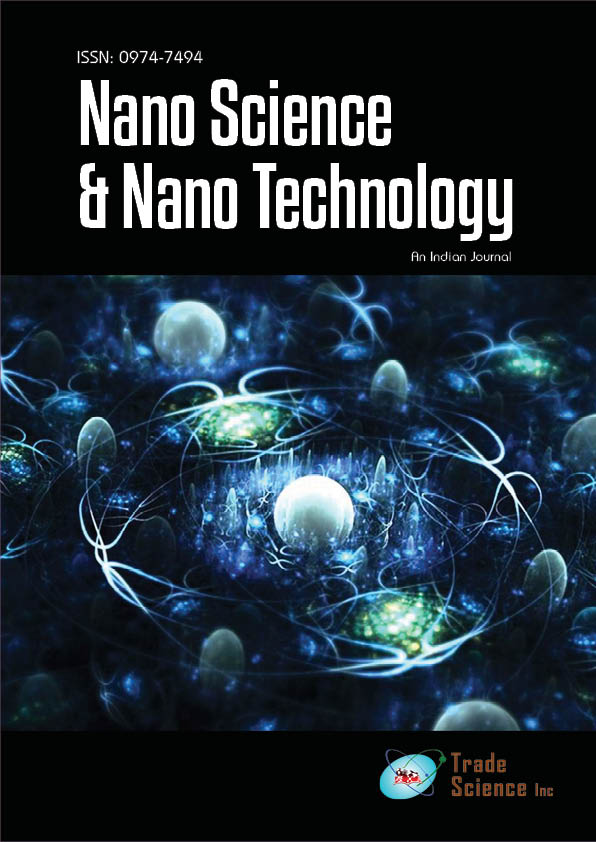Viewpoint
, Volume: 16( 1) DOI: DOI: 10.37532/ 0974-7494.2022.16 (1)Nano-Medicine with Melanin-Like Properties for Photo-thermal Therapy
- *Correspondence:
- Mylo MorgonEditorial Office, Nanoscience & Nanotechnology: An Indian Journal, UK.,E-mail:info@tsijournals.com
Citation: Morgan M. Nano-medicine with Melanin-Like Properties for Photo-Thermal Therapy. Nano Tech Nano Sci Ind J. 2022;16(1):145
Abstract
Cancer has always been a serious hazard to human health. According to WHO (World Health Organization) figures from 2015, cancer has become the leading cause of death in 91 nations under the age of 70. Traditional cancer treatments such as surgery, radiation, and chemotherapy have decreased the burden of cancer to some extent, but high systemic toxicity and multidrug resistance issues have forced individuals to seek alternative therapeutic options. Photo-Thermal Treatment (PTT) mediated by nanomaterials turns absorbed light energy into heat via the photo-thermal conversion characteristic of Nano-carriers, resulting in a fast rise in local temperature.
Introduction
Cancer has always been a serious hazard to human health. According to WHO (World Health Organization) figures from 2015, cancer has become the leading cause of death in 91 nations under the age of 70. Traditional cancer treatments such as surgery, radiation, and chemotherapy have decreased the burden of cancer to some extent, but high systemic toxicity and multidrug resistance issues have forced individuals to seek alternative therapeutic options. Photo-Thermal Treatment (PTT) mediated by nanomaterials turns absorbed light energy into heat via the photo-thermal conversion characteristic of Nano-carriers, resulting in a fast rise in local temperature.
Preparation method and polymerization of melanin like NPS
Biological extraction and chemical synthesis are the two main methods for producing melanin-like NPs. Polymerization mechanisms vary depending on the approach. Direct separation and purification of spherical nanoparticles from cuttlefish ink (as well as other materials like black sesame, hair, and Lachnum singerianum YM296), or reprocessing granules of cuttlefish ink to obtain ultra-small water-soluble melanin nanoparticles are examples of the former method. Large particles were removed using low-speed centrifugation, and subsequently, nanoparticles measuring 150 nm–200 nm were obtained using high-speed centrifugation (18000 rpm, 15 min). The lack of a uniform standard purification technique hampered the use of this physical extraction approach. Furthermore, the natural nanoparticles' composition lacked a distinct composition ratio and chemical structural information.
UV-vis absorption and photo-thermal conversion performance
Melanin-like NPs exhibit a wide UV-Vis adsorption spectrum that increases monotonically as energy increases. The disordered fundamental chemical structures and excitonic effects of secondary structures are thought to be responsible for the vast variety of monotonical absorption patterns. The capacity of melanin-like NPs to efficiently transform absorbed light energy into heat is one of their best optical features. Synthetic melanin-like nanomaterials can achieve higher optical characteristics than real melanin by employing a computational modeling technique to tune the nanostructures. Melanin-like nanomaterials have gotten a lot of attention in the field of photoacoustic imaging and photothermal treatment because of their unique features.
Application in nano-medicine
Due to their biocompatibility and strong photo-thermal characteristics, melanin-like NPS outperform several inorganic nanomaterials in the field of Nano-medicine. In addition, it had been demonstrated that PDA NPs treated at large doses showed no harm in vivo or in vitro. Photo-thermal conversion ability makes melanin-like NPs a more appealing platform for biological application development. We outline some recent research on their uses in cancer photothermal therapy during the last decade (monotherapy combination therapy and bi-model synergistic therapy). This study also discussed additional key uses of melanin-like NPs in biomedicine, such as biological imaging platforms and the treatment of different disorders (anti-oxidant damage, irradiation protection, etc.).
Biological imaging platform
Melanin-like NPs have gotten a lot of interest in the field of Nano-imaging because of their great physicochemical features. The intrinsic Photoacoustic Imaging (PAI) capabilities of melanin-like NPS enabled high contrast and resolution tissue imaging, which has a wide range of applications in disease diagnostics and efficacy evaluation. Some endogenous chromophores, such as hemoglobin, can, nevertheless, create excessive background signals. Furthermore, as compared to other imaging modalities such as PET imaging, PAI has poor tissue penetration.
Fluorescence Imaging (FI)
Melanin-like NPs have gotten a lot of interest in the field of fluorescence imaging because of their remarkable biocompatibility and optical qualities. Under extreme oxidative circumstances, melanin-like NPs show apparent fluorescence characteristics (e.g., light exposure and H2O2). Zhang created biocompatible Fluorescent Organic NPs (FONs) using one-pot oxidation of PDA utilized for cell imaging in a recent paper. After internalization by NIH-3T3 cells, these PDA-based FONs with tunable photoluminescence demonstrated green and yellow fluorescence under 405 nm and 458 nm excitations, respectively. Chen et al. produced F-PDA capsules in another study by polymerizing DA on sacrificial templates in the presence of H2O2. Under the 400 nm laser irradiation, the final F-PDA capsules showed a green influence, and the fluorescence intensity was pH-dependent (from pH 3–8).
The manufacturing techniques, internal mechanism, and physicochemical features of melanin-like NPs were all thoroughly addressed The manufacturing techniques, internal mechanism, and physicochemical features of melanin-like NPs were all thoroughly addressed in this study. At the same time, it provides a complete overview of the use of melanin-like NPs in cancer photothermal treatment during the last 10 years. This outstanding photothermal conversion agent demonstrated a potent anticancer impact in both single and combination photothermal treatment. What's more, because their chemical structure is identical to that of natural melanin, they're biocompatible and harmless. As a result, melanin-like NPs are predicted to emerge as a new generation of clinical photothermal treatment candidates.
The manufacturing techniques, internal mechanism, and physicochemical properties of melanin-like NPs were thoroughly discussed in this study. At the same time, it provides a comprehensive overview of the use of melanin-like NPs in cancer photothermal treatment during the last 10 years. Whether used alone or in combination, this superb photothermal conversion agent demonstrated potent anticancer effects. What's more, because their chemical structure is identical to that of natural melanin, they're biocompatible and harmless. As a result, melanin-like NPs are predicted to emerge as a new generation of clinical photothermal treatment candidates. We think that this highlighted article will help readers grasp the latest research trends in the field of photothermal treatment and will serve as a reference for future research.
In conclusion, in the last decade, research on melanin-like NPs for photothermal treatment has made tremendous progress. With the flourishing study of melanin-like NP, it is easy to imagine that in the near future, it will break through the existing difficulty and expedite the clinical transformation of photothermal anti-tumor treatment.

